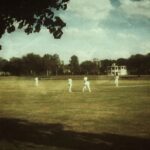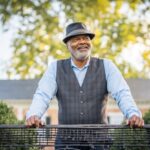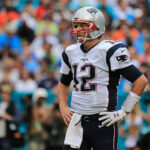Through The Eyes of…Buddy Biancalana: Forever A World Series Hero
The following is part of a weekly series called “Through the Eyes of…” In each segment, I share interviews with or stories about those I view to be the “Good Guys.”
“Through the Eyes of…” is a part of my personal crusade to present baseball in all its beauty, splendor, and goodness, instead of through hashing and rehashing all that is broken with our national treasure.
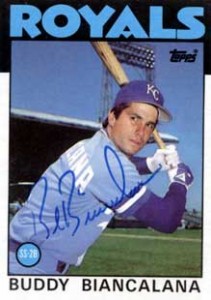
1983 Baseball Card of our hero, Buddy Biancalana
After spending twenty minutes and twenty dollars in the batting cage with my son this weekend, I exited the cage with several quarter sized blisters on my Avon Skin So Soft hands and a case of heartburn after ingesting a huge dose of humility.
I came to several conclusions as I tossed my batting helmet and bat in disgust.
Aging is a cruel, cruel reality that I simply haven’t yet come to grips with. How a man can get winded, while swinging and missing at a slow pitch softball is beyond me.
Second, when your wife tells you that she’s not laughing at you, she’s laughing with you, she’s only being kind.
Third, hitting a round object with a wooden stick that is hurled in your direction at 90+ miles an hour, must be the most difficult accomplishment in sports. For those of us who sit at home cursing at any of these athletes who still manage to hit one ball in four, should take a few cuts in their cleats before playing arm chair manager.
So, despite the fact that former Major League shortstop Buddy Biancalana will forever live with a career average of .205 in the forever annuls of baseball lore, Biancalana has a lot of things that most of his can only dream about.
While most of us are carving our legacy while working as the cashier at Wal-mart or asking if our customers would like it Super Sized, Biancalana will always be able to tell his grandchildren that he was a former Major League player.
While each of us could only dream of getting even one major league hit, Biancalana has 113 to his credit, while driving in 30 of his teammates over six major league seasons with the Kansas City Royals and the Houston Astros.
And while my blistered hands and I sit home and watch the World Series this coming October and dream of what it would have been like to plate in the Fall Classic, Buddy Biancalana will be polishing his 1985 World Series ring and remembered the two weeks that time stood still, the ball looked bigger and he was experiencing a series in the zone that would not only change his career, but would become the Foundation for his current business venture PMPM Sports.
Oh, yeah and did I happen to mention he appeared on Late Night With David Letterman, got to hang for several seasons with George Brett and Nolan Ryan and can still fit his 49 year-old frame into rookie Royals uniform, Burger Boy?
My point is, before you and the host of Late Night TV tease Buddy Biancalana about his light hitting, slick fielding statistics, try spending a few minutes in the batting cage.
Hey honey, do you know where the pumice stone is?
Buddy was nice enough to share his thoughts with me about baseball and about his company PMPM Sports. I found him to be funny, kind and very knowledgeable about the psychological side of hitting and about what his findings can do to help athletes in many sports.
Biancalana and his partner Steve Yellin are the co-founders of PMPM Sports and use their knowledge and studies of Perfect Mind-Perfect Motion to help athletes bring their game to a new level.
Yellin has been teaching tennis and golf for over 30 years and is responsible for developing the innovative and powerful drills that PMPM Sports uses to allow athletes in all sports to reach their full potential.
He was the Florida High School state tennis champion, and went on to play number one singles on the University of Pennsylvania tennis team. He was a member of the All-Ivy League tennis team in 1973, played in the 1973 NCAA National Championship, and was invited to play on the 1972 Israeli Davis Cup team. Yellin also holds two masters degrees in Business and Education.
And now, Through The Eyes of Buddy Biancalana: Still A World Series Hero.
BB: I believe Brian Kingman. It was the last game of the season and Mike Heath, a catcher, was playing right field. I hit a line drive that he ran in for and the ball sailed over his head. I was thrown out at the plate trying to stretch it to an inside the park home run.
Civ: You also walked and were therefore 1 for 2 with a walk in three PA for your career. Any thoughts of hanging it up at that point?
Civ: What was that off season like knowing your were hitting .500 with a .667 OBP and a 1.500 slugging percentage?
Civ: As a .205 life time hitter, was there any pitcher who you had considerable success against?
BB: No one in the Majors. I did hit three home runs in a week against a Minor League pitcher, Tommy Joe Shimp. Does that count?
Civ: What was it like playing with George Brett?
BB: It forced me to become very good at catching pop ups. He didn’t want much to do with them. Watching him and Hal McRae taught me how to play an aggressive style of baseball.
Civ: Statistically you were a light hitter as a major leaguer, I think the readers would be interested in hearing how a lighter hitter makes it to the bigs. What did you hit as a high schooler? College?
BB: A bit over .300 as a junior in HS and around .285 as a senior. I had three above average tools, glove, arm and speed. That’s what got me drafted in the first round, ahead of Cal Ripken I may add. Poor Art Lilly, the scout who signed me!
Civ: You took some razzing by David Letterman during Pete Rose’s quest to catch Ty Cobbs hits record. What were your thoughts while it was going on? What was it like to appear on Late Night?
BB: I had a lot of fun with it. It gave me some publicity when my play wasn’t. Although, it was my performance in the World Series that got me on the show. It opened many doors for me.
Civ: There have been 11 players ever drafted out of your high school Redwood High and you were the only one to make it to the major leagues, does the school have a Buddy Biancalana day? Do you ever see your old coach? What did he tell you?
BB: Actually Chad Krueter graduated from Redwood. NBC filmed a Sports Fantasy show with me at the high school after the Series, and the county of Marin had a day for me. I do stay in touch with my coach Al Endriss. He was a major influence on my career.
Civ: Of the 26 first round picks in the 1978 draft, 14 made it to the show, amongst them Kirk Gibson, Tom Brunansky and Lloyd Moseby, did you play against any of them in HS or college? Minors? Do players even know or care about this kind of thing?
BB: I played on a scout team in high school with Moseby and also the Minors along with Rex Hudler and I’m sure others, but don’t recall. Yes, I think players are aware of who first round picks are, especially from the same draft. It’s a bit of a common bond.
Civ: What do players say to each other when they reach base. I always see them talking. Do you even know other players or is it small talk.
Civ: Do you ever see any ex-teammates?
BB: Every now and then. We had our 20 year reunion for our World Series team. Great fun. All the same one liners were flowing. It was as if there was no time lapse.
Civ: What was your funniest baseball moment or story?
BB: Quite possibly when I was put on the disabled list and in our clubhouse. All of a sudden, a big laundry basket was pushed towards me by Lee May. As it approached, up popped Hal McRae aiming a fungo at me simulating a shot gun, pretending to shoot me, because I was of no use to the team. It was very funny. They were two of my favorite team mates.
Civ: Tell me about the events in the 1985 series and how did you know you were in the zone? Which came first, being in the zone or your first hit?
BB: Not sure I know for sure. But, before Game One I felt intensely nervous. For the first time in my life, I remember really identifying and sitting with, and feeling the fear. It was very freeing and empowering. It had a lot to do with freeing me up to play the best I had ever played. In my first at bat in Game One, I failed to get a bunt down in the third inning on a squeeze attempt. We ended up losing 3-1 and the media jumped on it pretty good. I felt a lot of pressure before Game Two, but again, I sat with it and remained pretty freed up. Being emotionally free is one component to being in the zone.
Civ: I know you were a proponent of Transcendental Meditation (TM). Did PMPM come out of your knowledge of TM?
BB: Any technique that reduces stress and enhances the mind body connection, will be beneficial to an athlete and anyone in general. The less stress in one’s nervous system, the better the mind-body coordination will be. TM is not a part of our program.
Civ: Can these techniques be used outside of the sporting arena?
BB: Yes, very much so. We have worked with a few musicians and stock traders. My wife told me she used them
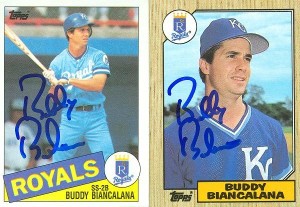
Buddy Biancalana Double Panel Tops Card 1984
driving through the fog recently, when it was difficult seeing the lines. We have clients who have done better on tests and even were able to go off medication for ADHD.
Civ: What players have come to you and use your techniques?
BB: Players whose names we can mention are, two time US Open Champion, Lee Janzen, Bob Keppel of the Twins, Kyle Davies of the Royals, Minor Leaguers Daryl Jones and Adam Ottavino of the Cardinals and George Brett for his golf game. There are many others whose names we can not mention for privacy purposes.
Civ: I know Nick Green of the Red Sox was a client. He started the season hitting in the .280’s and has come back to earth to hit “the back of his baseball card”. Did he depart from your techniques or do role players eventually come back to earth?
BB: Every player is different. We began working with Nick a few years ago and he had tremendous results. He exceeded his career average by 59 points and previous HR total by 19. He was able to resurrect his career, but our program is not a panacea. We have identified the processes in the mind that allow an athlete to play his best and developed a systematic way to teach it.
Civ: Why don’t some of the bigger names use your techniques?
BB: Give us time! We are three years into bringing this knowledge into sports and it is knowledge that has never been mentioned before. New discoveries take time. Teams and agents are sending us players who are under performing, but our program is not just for those players. Our program is for any player who wants a clear understanding of why he plays well sometimes and not other times.
Civ: Who is the biggest name using PMPM?
BB: I would have to say Lee Janzen who is turning things around.
Civ: How does this differ from sports psychology?
BB: Our work takes place on the field. We work in the arena of the state of mind at impact or release point for an athlete. That is the moment of truth. That and the state of mind just before the motion begins, will determine the fluidity and effectiveness of the motion, and the ability for an athlete to make a last split second adjustment. We often times refer clients to sports psychologists.
Civ: Have you been hired by any teams or strictly individuals?
BB: We did a test pilot last season with five St.Louis Cardinal Minor League hitters and are proud to report, the five showed an average increase in OPS of 100.8 points versus a decrease of 22.45 points for the rest of the Minor League hitters with whom we did not work. We had similar results with one of their pitchers.
Some prominent college basketball programs have attempted to hire us, but we are still working through the logistics of complying with the NCAA.
Civ: What does a day in the life of a PMPM customer consist of?
BB: When we are with them, we will be on their respective practicing field, in the cage, on the mound, golf course, basketball court etc. Depending on the sport, we will spend an hour or more with them as they are practicing what we teach. They will view videos when we are not with them and speak to us as needed.
Civ: You talk about your what if’s…What if you had discovered this while you were playing, what difference would that have made in your overall numbers?
BB: Substantial. I was unable to sustain mechanical adjustments because of the lack of fluidity in my mind at the time. Anytime an athlete knows exactly where to look so they may produce the best motion available to them, will have a large impact on their performance
Civ: What if Ichiro used your company or techniques?



